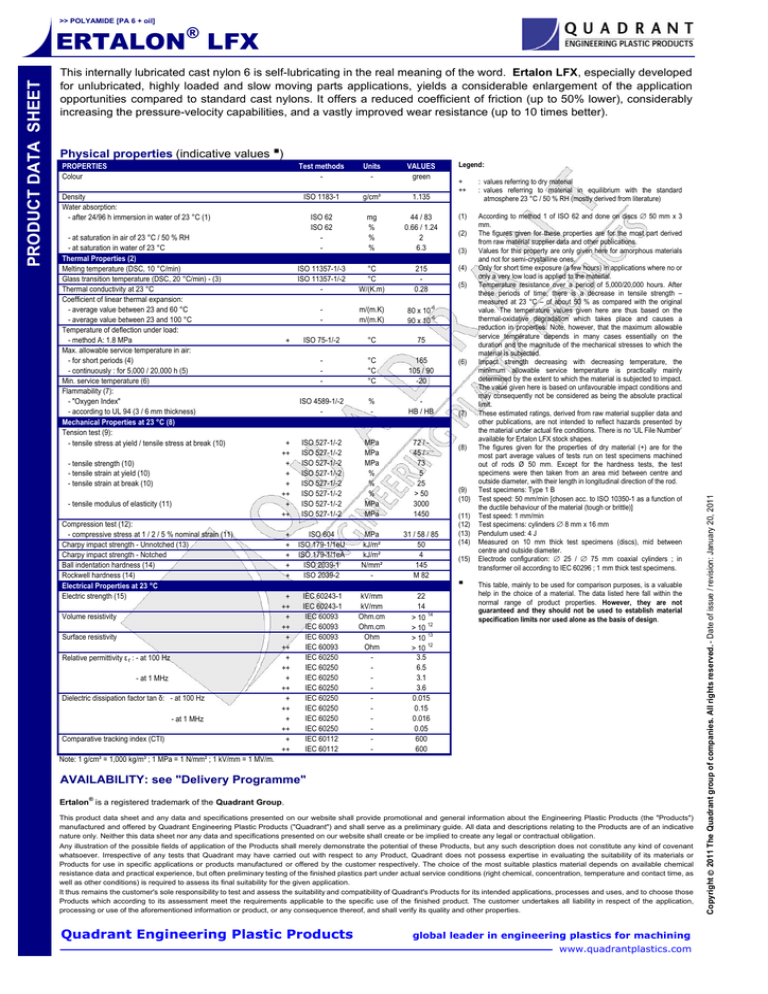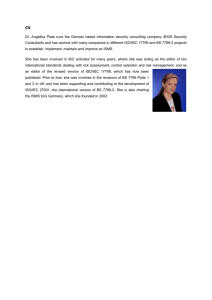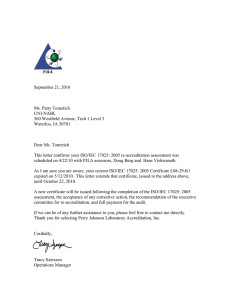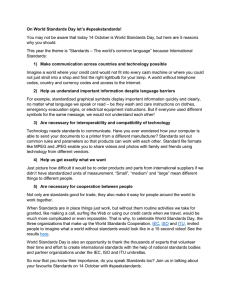
>> POLYAMIDE [PA 6 + oil]
This internally lubricated cast nylon 6 is self-lubricating in the real meaning of the word. Ertalon LFX, especially developed
for unlubricated, highly loaded and slow moving parts applications, yields a considerable enlargement of the application
opportunities compared to standard cast nylons. It offers a reduced coefficient of friction (up to 50% lower), considerably
increasing the pressure-velocity capabilities, and a vastly improved wear resistance (up to 10 times better).
Physical properties (indicative values g)
PROPERTIES
Colour
Density
Water absorption:
- after 24/96 h immersion in water of 23 °C (1)
- at saturation in air of 23 °C / 50 % RH
- at saturation in water of 23 °C
Thermal Properties (2)
Melting temperature (DSC, 10 °C/min)
Glass transition temperature (DSC, 20 °C/min) - (3)
Thermal conductivity at 23 °C
Coefficient of linear thermal expansion:
- average value between 23 and 60 °C
- average value between 23 and 100 °C
Temperature of deflection under load:
- method A: 1.8 MPa
Max. allowable service temperature in air:
- for short periods (4)
- continuously : for 5,000 / 20,000 h (5)
Min. service temperature (6)
Flammability (7):
- "Oxygen Index"
- according to UL 94 (3 / 6 mm thickness)
Mechanical Properties at 23 °C (8)
Tension test (9):
- tensile stress at yield / tensile stress at break (10)
- tensile strength (10)
- tensile strain at yield (10)
- tensile strain at break (10)
- tensile modulus of elasticity (11)
Compression test (12):
- compressive stress at 1 / 2 / 5 % nominal strain (11)
Charpy impact strength - Unnotched (13)
Charpy impact strength - Notched
Ball indentation hardness (14)
Rockwell hardness (14)
Electrical Properties at 23 °C
Electric strength (15)
Volume resistivity
Surface resistivity
Relative permittivity ε r : - at 100 Hz
Relative permittivity ε r : - at 1 MHz
Dielectric dissipation factor tan δ: - at 100 Hz
Dielectric dissipation factor tan δ: - at 1 MHz
Comparative tracking index (CTI)
+
+
++
+
+
+
++
+
++
Test methods
-
Units
-
VALUES
green
ISO 1183-1
g/cm³
1.135
ISO 62
ISO 62
-
mg
%
%
%
44 / 83
0.66 / 1.24
2
6.3
ISO 11357-1/-3
ISO 11357-1/-2
-
°C
°C
W/(K.m)
215
0.28
-
m/(m.K)
m/(m.K)
80 x 10-6
90 x 10-6
ISO 75-1/-2
°C
75
-
°C
°C
°C
165
105 / 90
-20
ISO 4589-1/-2
-
%
-
HB / HB
ISO 527-1/-2
ISO 527-1/-2
ISO 527-1/-2
ISO 527-1/-2
ISO 527-1/-2
ISO 527-1/-2
ISO 527-1/-2
ISO 527-1/-2
MPa
MPa
MPa
%
%
%
MPa
MPa
72 / 45 / 73
5
25
> 50
3000
1450
MPa
kJ/m²
kJ/m²
N/mm²
-
31 / 58 / 85
50
4
145
M 82
kV/mm
kV/mm
Ohm.cm
Ohm.cm
Ohm
Ohm
-
22
14
> 10 14
> 10 12
> 10 13
> 10 12
3.5
6.5
3.1
3.6
0.015
0.15
0.016
0.05
600
600
ISO 604
+
+ ISO 179-1/1eU
+ ISO 179-1/1eA
ISO 2039-1
+
ISO 2039-2
+
Legend:
+
++
: values referring to dry material
: values referring to material in equilibrium with the standard
atmosphere 23 °C / 50 % RH (mostly derived from literature)
(1)
According to method 1 of ISO 62 and done on discs ∅ 50 mm x 3
mm.
The figures given for these properties are for the most part derived
from raw material supplier data and other publications.
Values for this property are only given here for amorphous materials
and not for semi-crystalline ones.
Only for short time exposure (a few hours) in applications where no or
only a very low load is applied to the material.
Temperature resistance over a period of 5,000/20,000 hours. After
these periods of time, there is a decrease in tensile strength –
measured at 23 °C – of about 50 % as compared with the original
value. The temperature values given here are thus based on the
thermal-oxidative degradation which takes place and causes a
reduction in properties. Note, however, that the maximum allowable
service temperature depends in many cases essentially on the
duration and the magnitude of the mechanical stresses to which the
material is subjected.
Impact strength decreasing with decreasing temperature, the
minimum allowable service temperature is practically mainly
determined by the extent to which the material is subjected to impact.
The value given here is based on unfavourable impact conditions and
may consequently not be considered as being the absolute practical
limit.
These estimated ratings, derived from raw material supplier data and
other publications, are not intended to reflect hazards presented by
the material under actual fire conditions. There is no ‘UL File Number’
available for Ertalon LFX stock shapes.
The figures given for the properties of dry material (+) are for the
most part average values of tests run on test specimens machined
out of rods Ø 50 mm. Except for the hardness tests, the test
specimens were then taken from an area mid between centre and
outside diameter, with their length in longitudinal direction of the rod.
Test specimens: Type 1 B
Test speed: 50 mm/min [chosen acc. to ISO 10350-1 as a function of
the ductile behaviour of the material (tough or brittle)]
Test speed: 1 mm/min
Test specimens: cylinders ∅ 8 mm x 16 mm
Pendulum used: 4 J
Measured on 10 mm thick test specimens (discs), mid between
centre and outside diameter.
Electrode configuration: ∅ 25 / ∅ 75 mm coaxial cylinders ; in
transformer oil according to IEC 60296 ; 1 mm thick test specimens.
(2)
(3)
(4)
(5)
(6)
(7)
(8)
(9)
(10)
(11)
(12)
(13)
(14)
(15)
g
+
++
+
++
+
++
+
++
+
++
+
++
+
++
+
++
IEC 60243-1
IEC 60243-1
IEC 60093
IEC 60093
IEC 60093
IEC 60093
IEC 60250
IEC 60250
IEC 60250
IEC 60250
IEC 60250
IEC 60250
IEC 60250
IEC 60250
IEC 60112
IEC 60112
This table, mainly to be used for comparison purposes, is a valuable
help in the choice of a material. The data listed here fall within the
normal range of product properties. However, they are not
guaranteed and they should not be used to establish material
specification limits nor used alone as the basis of design.
Note: 1 g/cm³ = 1,000 kg/m³ ; 1 MPa = 1 N/mm² ; 1 kV/mm = 1 MV/m.
AVAILABILITY: see "Delivery Programme"
Ertalon® is a registered trademark of the Quadrant Group.
This product data sheet and any data and specifications presented on our website shall provide promotional and general information about the Engineering Plastic Products (the "Products")
manufactured and offered by Quadrant Engineering Plastic Products ("Quadrant") and shall serve as a preliminary guide. All data and descriptions relating to the Products are of an indicative
nature only. Neither this data sheet nor any data and specifications presented on our website shall create or be implied to create any legal or contractual obligation.
Any illustration of the possible fields of application of the Products shall merely demonstrate the potential of these Products, but any such description does not constitute any kind of covenant
whatsoever. Irrespective of any tests that Quadrant may have carried out with respect to any Product, Quadrant does not possess expertise in evaluating the suitability of its materials or
Products for use in specific applications or products manufactured or offered by the customer respectively. The choice of the most suitable plastics material depends on available chemical
resistance data and practical experience, but often preliminary testing of the finished plastics part under actual service conditions (right chemical, concentration, temperature and contact time, as
well as other conditions) is required to assess its final suitability for the given application.
It thus remains the customer's sole responsibility to test and assess the suitability and compatibility of Quadrant's Products for its intended applications, processes and uses, and to choose those
Products which according to its assessment meet the requirements applicable to the specific use of the finished product. The customer undertakes all liability in respect of the application,
processing or use of the aforementioned information or product, or any consequence thereof, and shall verify its quality and other properties.
Quadrant Engineering Plastic Products
global leader in engineering plastics for machining
www.quadrantplastics.com
Copyright © 2011 The Quadrant group of companies. All rights reserved. - Date of issue / revision: January 20, 2011
PRODUCT DATA SHEET T
ERTALON® LFX






